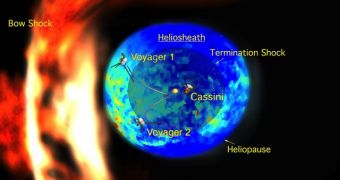In addition to supplying space agencies with invaluable data on the moons of Saturn and the gas giant itself, the Cassini spacecraft is also helping in our quest to learn more about our solar system. As we move through the local Milky Way galaxy, the space probe is taking non-stop measurements as to the nature of our extended home, and reveals new data that challenge existing beliefs. In the recent study, Cassini looked at energetic neutral atoms, a type of particles that permeate the solar system, as well as areas around it, experts from the Jet Propulsion Laboratory announce.
Previous models held that our star system looked very much like a comet because we were moving along a certain path through the interstellar medium, the matter that exists between the stars in our galaxy. Drag produced by this motion could have thus rightfully created a “tail,” as seen in comets. But the new Cassini readings appear to paint a different picture, hinting at the fact that the shape of the system may actually be spherical. This, in addition to contradicting scientific theories, also does not make too much sense, which is not to say that it isn't true, or that experts do not believe the measurements.
“At first I was incredulous. The first thing I thought was, 'What's wrong with our data'?” Johns Hopkins University (JHU) Applied Physics Laboratory (APL) expert Tom Krimigis says. The scientist is also the principal investigator of the Magnetospheric Imaging Instrument (MIMI) device, aboard Cassini. In fact, astronomers believe, the shape of our solar system resembles more a rat passing thorough the guts of a boa constrictor. The local interstellar magnetic field represents the ribs of this magnificent snake, which move apart as the rat is pushed further down the hatch.
“These new data from Cassini really redefine our sense of our home in the galaxy, and we can now do better studies of whether our solar system resembles those elsewhere,” Krimigis adds. “I was initially skeptical because the instrument was designed for Saturn's magnetosphere. But our camera had long exposures of months to years, so we could accumulate and map each particle that streamed through the tiny aperture from the far reaches of the heliosphere. It was luck, but also a lot of hard work,” APL researcher and MIMI instrument scientist Don Mitchell concludes.

 14 DAY TRIAL //
14 DAY TRIAL //